
The Basque region in northern Spain, known in Basque as Euskadi, has a personality that’s quite different from the south of the country. In our 7 day Basque Country itinerary, we take you to the vibrant cities of Bilbao and San Sebastian, visit picturesque coastal towns, explore the region’s proud history and sample some amazing food.


The countryside here is green and lush, with plentiful rain and warm summers, as well as a rugged Atlantic coastline. Basque culture and spirit of independence is thriving, so expect to hear the Basque language widely spoken.
Of course, our 1 week Basque Country travel guide can only cover a fraction of all the places to visit in Basque Spain. In order to travel more sustainably, we’ve focussed on coastal route with great bus and train links, so you can relax and save money by going car free.
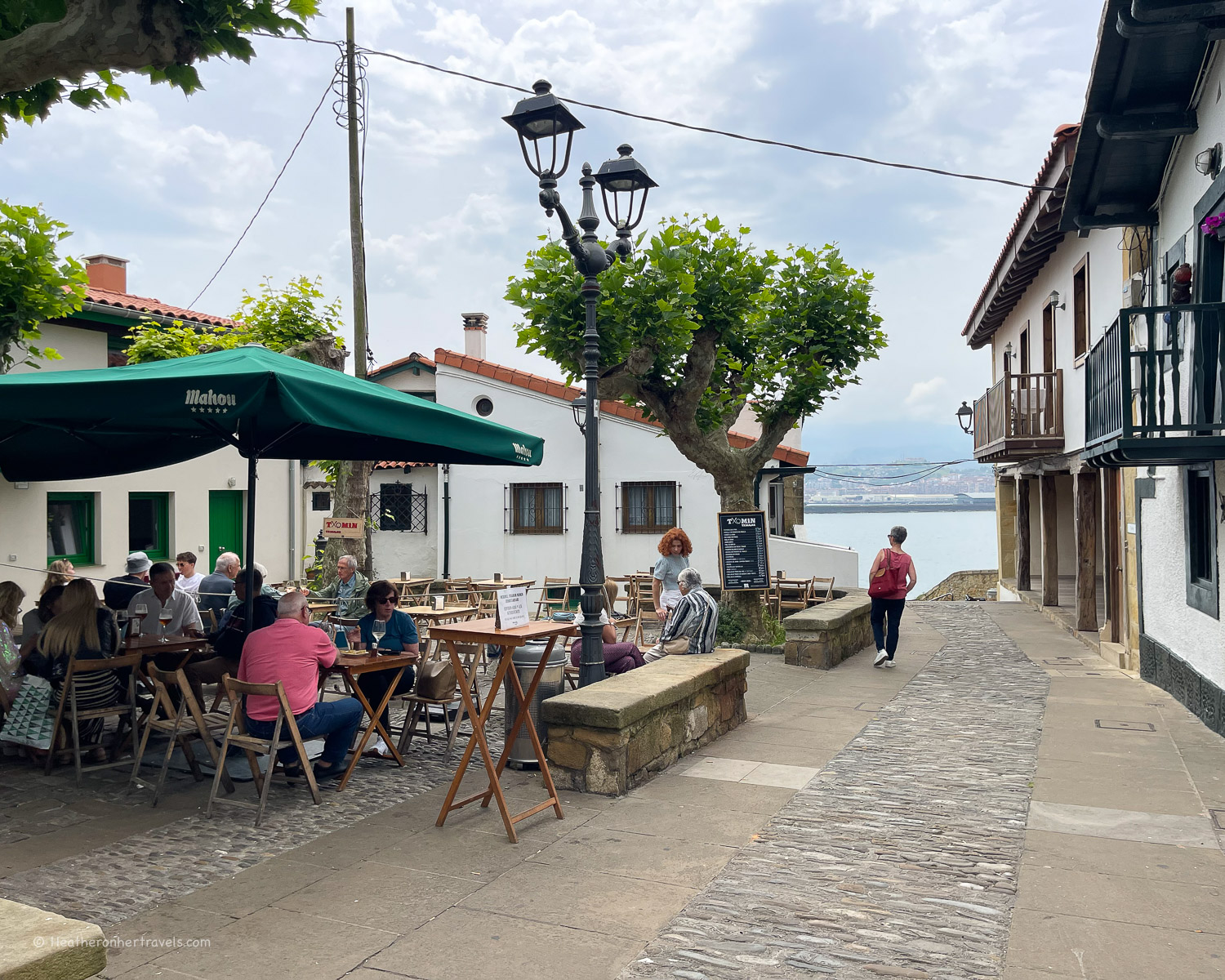
 Old Port Getxo Spain
Old Port Getxo Spain
But of if you have more time or choose to hire a car, there’s plenty to see in the towns and rolling countryside that lie inland.
This article may contain affiliate links that provide commission on purchases you make at no extra cost to you. As an Amazon Associate I earn from qualifying purchases.

 Old Port Getxo Spain
Old Port Getxo Spain
1 week itinerary for Basque Spain
Here’s an overview of your 1 week Basque Country itinerary. Using Bilbao and San Sebastian as a base, you’ll discover some of the top places to see in the Basque Country.

 Salbeko Zubia bridge Bilbao Spain
Salbeko Zubia bridge Bilbao Spain
Day 1 – Arrive in Bilbao, explore the Old Town (book a hotel for 3 nights in Bilbao)
Day 2 – Bilbao – the Guggenheim and riverside walk
Day 3 – Day Trip from Bilbao to San Juan de Gaztelugatxe, Bermeo and Gernika
Day 4 – Take the bus from Bilbao to San Sebastian – in the afternoon explore the Old Town and harbour. (Book a hotel for 3-4 nights in San Sebastian)
Day 5 – San Sebastian – Beaches, surfing or a boat trip – then enjoy Pintxos in the Old Town
Day 6 – Day Trip from San Sebastian to either Getaria or Hondarribia on the Basque coast
Day 7 – San Sebastian – Monte Igueldo and Ondarreta beach. In the afternoon take the bus to Bilbao or Biarritz for a flight home or continue by train to other locations in Spain.
Day 1 – Arrive in Bilbao – explore the Casco Viejo
Bilbao has the main international airport for the Basque Country, so we’ll start our week’s tour here. However you could also fly into Biarritz in France and then start the tour in San Sebastian, or arrive to either city by train.
The regular and inexpensive A3247 airport bus takes 20 minutes from Bilbao airport to the city centre. We recommend staying in either the Abando / Abandoibarra “New Town” neighbourhood near the Guggenheim, or in the Casco Viejo “Old Town”.
If you haven’t already done so, we recommend booking a timed entry ticket for the Guggenheim, as it can get very busy.

 Tram in Bilbao Spain
Tram in Bilbao Spain
On arrival also consider buying a Barik transport card at any train or metro station for €3, then charge this at tram, train and metro stations in €5 increments. Use it to tap on / tap off when you use the tram, bus or metro, so you don’t have to buy individual tickets.
Day 1 – Afternoon
Once you’ve settled into your accommodation, take the tram or walk to the Casco Viejo “Old Town”.
- Stop at the Art Deco Mercado de la Ribera, a landmark on the riverfront near the Old Town (closed Mondays). Wander around the different market stalls, selling the best of Basque produce, then take a seat in the food court of Pintxos stalls if you need a light lunch.

 Mercado de la Ribera in Bilbao Spain
Mercado de la Ribera in Bilbao Spain
- Dive into the grid of streets, known as Las Siete Calles or “Seven Streets”, the original streets of the Old Town dating back to the 14th century. There are numerous cafes in the Old Town, whenever you need a break.
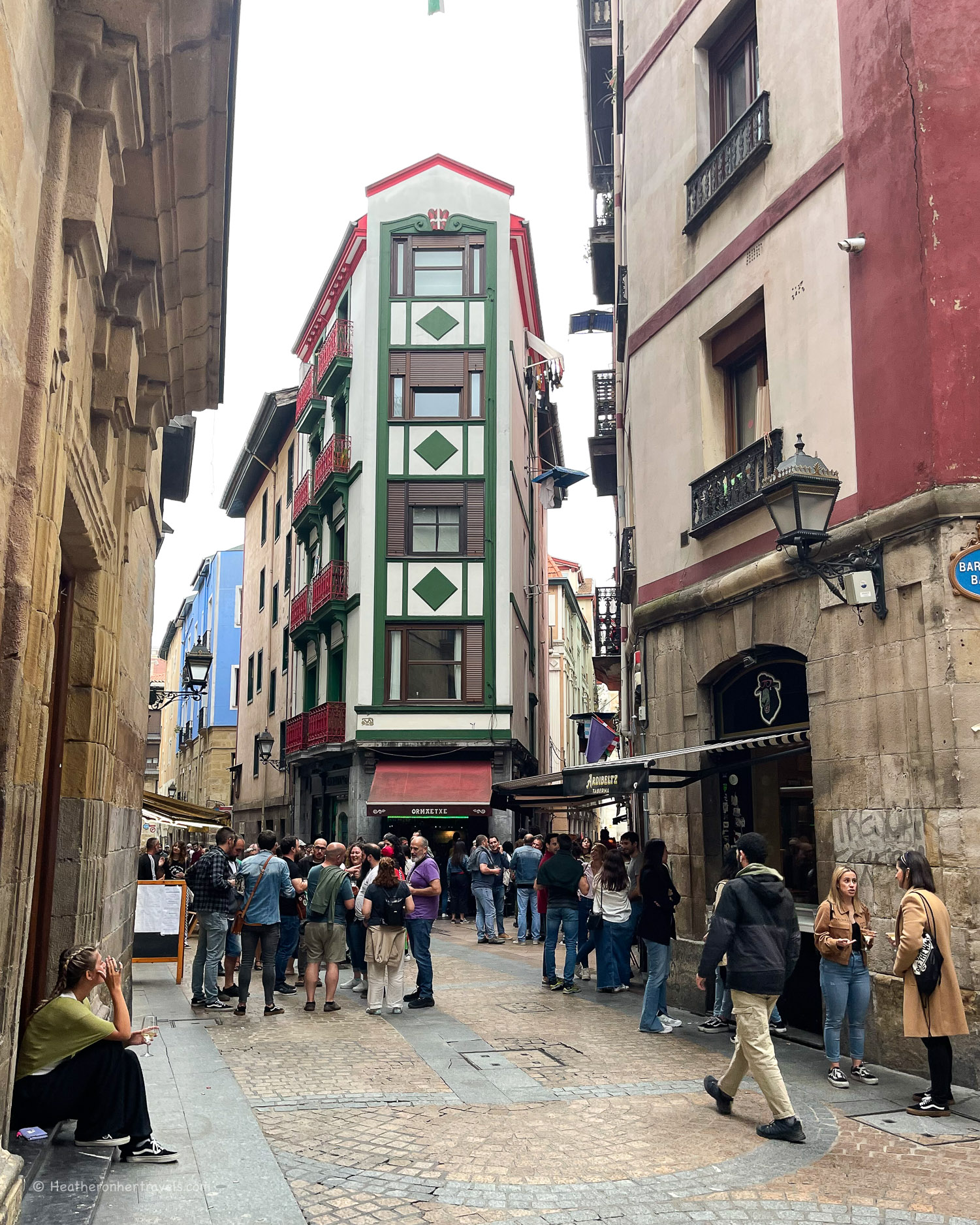
 Las Siete Calles in Bilbao Spain
Las Siete Calles in Bilbao Spain
- The Catedral de Santiago, Bilbao’s oldest church, stands in a small square at the heart of the old town. On nearby Txakur street, is an old stone water fountain, that still dispenses potable water from the three dog’s head taps.
- On the corner of Calle Pilota and Calle Santa María is a small stone carving with the Hucha de los Txikiteros or “Piggy Bank” of the groups known as Txikiteros who gather in local bars to drink and sing traditional Basque songs. This is where they deposit their small change at the end of the night, which is distributed to local charities.
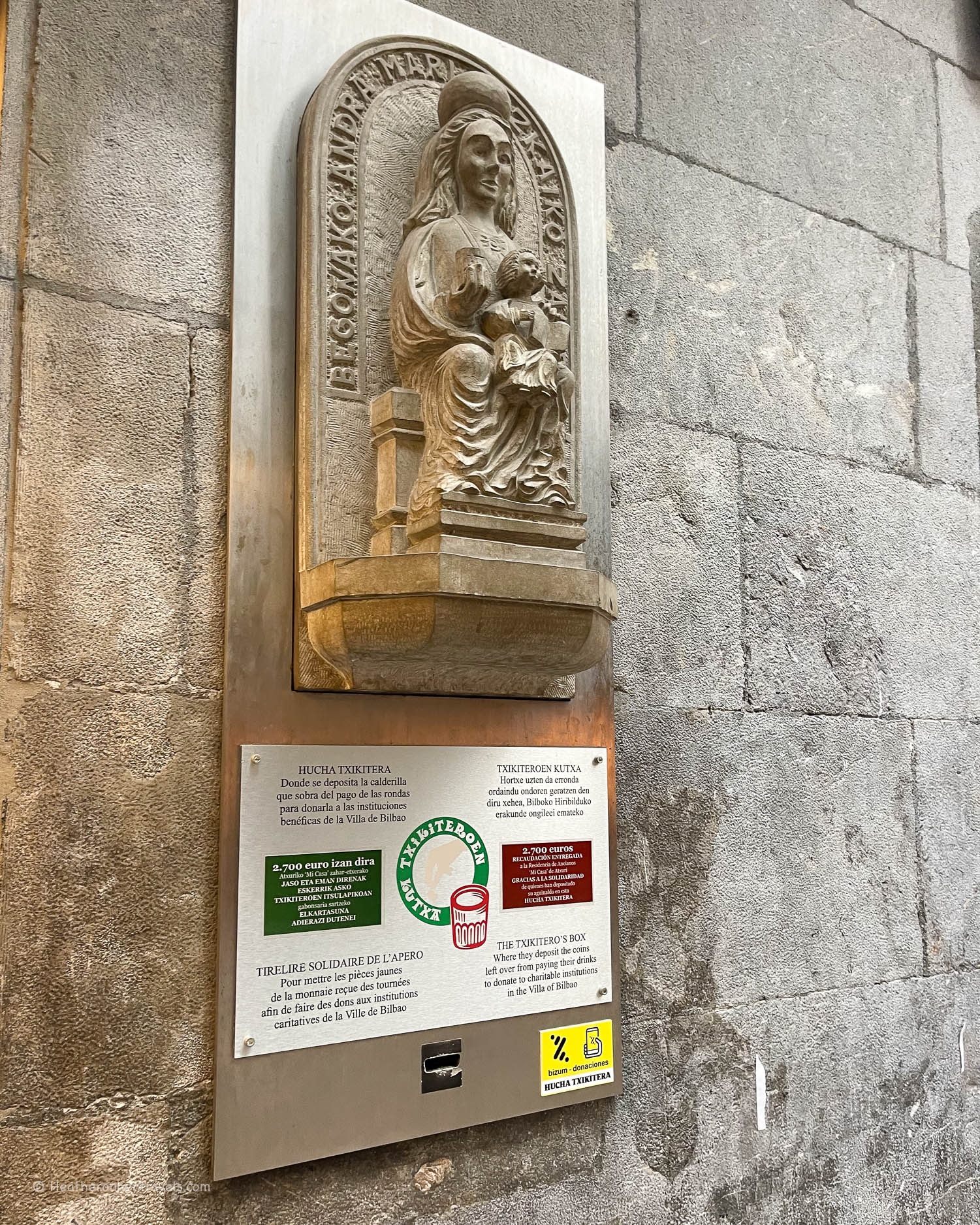
 Hucha de los Txikiteros in Bilbao Spain
Hucha de los Txikiteros in Bilbao Spain
Day 1 – Evening
For something to eat we recommend heading to Plaza Nueva, a large open square in the Old Town, with plenty of bars and restaurants under the arcades. It’s calm and relaxed by day, but comes to life in the evening as a convivial place to try the Basque speciality of Pintxos.

 Plaza Nueva Bilbao Spain
Plaza Nueva Bilbao Spain
Pronounced Pin-chos they are small snacks like tapas, based on a round of bread with different toppings. It’s a typical Basque tradition to go bar-hopping with friends, taking a drink and a Pintxos or two in each bar, before moving on to the next.
These snacks typically use local Basque produce, like anchovies, tuna, seafood, slow cooked pork, pimentos and local cheeses. If you want something more substantial, order some hot pintxos or the small plates (raciones) from the menu.

 Gure Toki Pintxos in Bilbao Spain
Gure Toki Pintxos in Bilbao Spain
In Plaza Nueva we especially rated Gure Toki (Michelin recommended) for their inventive and tasty Pintxos and Victor Montes with a beautiful traditional shopfront.
For more information on Bilbao, read my article on 19 top things to do in Bilbao.
Day 2 – Bilbao – The Guggenheim and riverside walk
Depending when you have booked tickets for the Guggenheim, the morning and afternoon activities are interchangeable.
Day 2 – Morning – a riverside stroll
Enjoy the stroll along the Nervión river, which has promenades on both banks between the Old Town and the Guggenheim. The formerly industrialised riverscape now offers street art, sculpture and views of Bilbao’s many bridges.
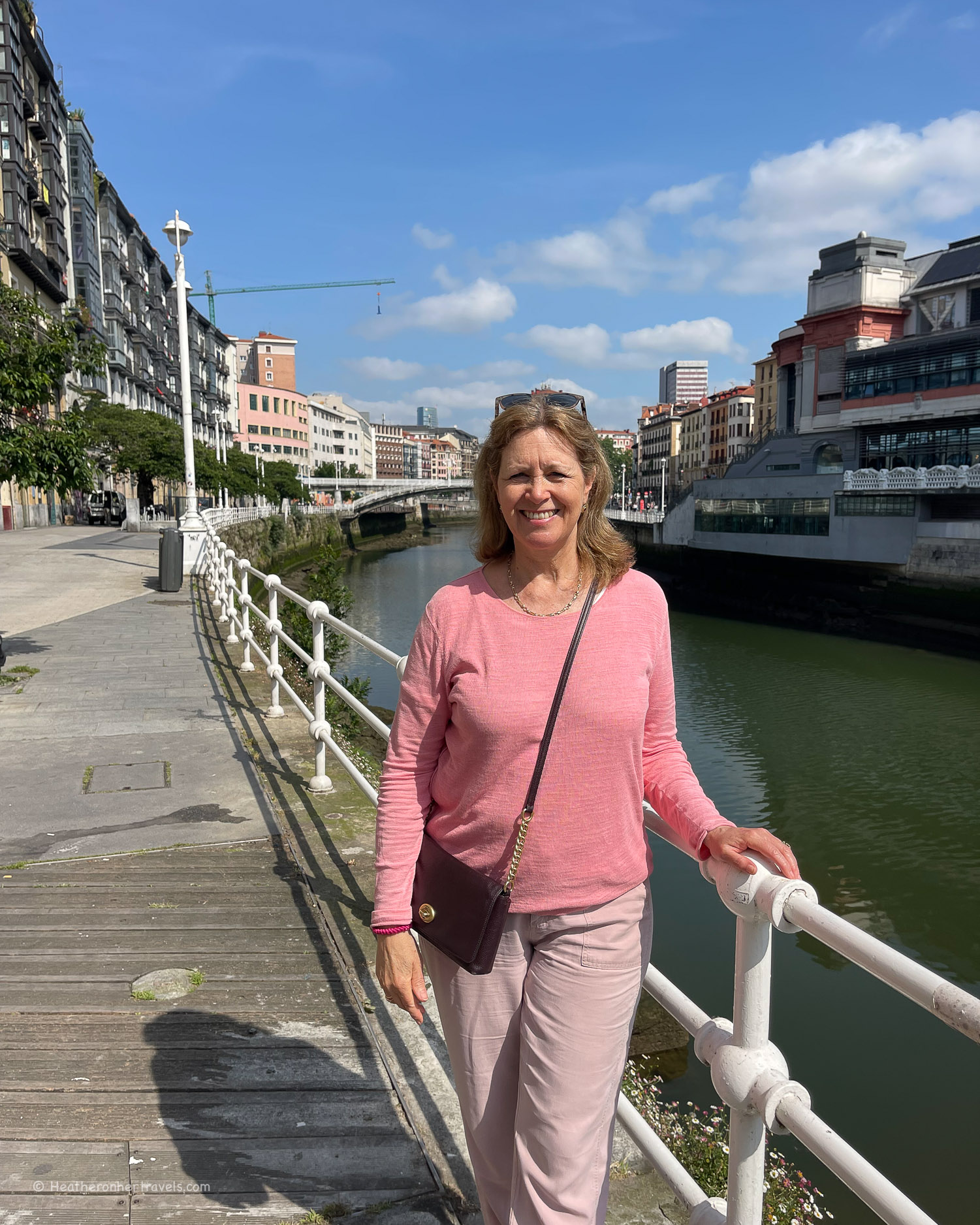
 Riverside Walk Bilbao Spain
Riverside Walk Bilbao Spain
While walking along the river from the Old Town to the Guggenheim, look out for:
- Between the Mercado de la Ribera and the 14th century St Anton’s Bridge, enjoy the views of some colourful and beautiful restored riverside buildings, some of which now have small restaurants at the street level. If you haven’t already visited the market, now’s the time top pop in.

 Riverside Walk Bilbao Spain
Riverside Walk Bilbao Spain
- Near Plaza de Arenal is the Teatro Arriaga, an attractive theatre dating back to 1890, that puts on opera and musicals.
- Plaza de Arenal is a shady open park with fountains, floral displays and a Belle Epoque bandstand used for outdoor concerts.
- Across the river, admire the Belle Epoque stained glass frontage of Concordia station which you can see from Plaza de Arenal.

 Concordia Station Bilbao Spain
Concordia Station Bilbao Spain
- Behind Concordia station is the busy Abando station. Take the escalators up to the railway level, to see a colourful stained glass mural, depicting scenes from Basque culture, agriculture and industry.
- A little further along the river is the Zubizuri bridge, a footbridge designed by Santiago Calatrava, with the architect’s signature white curving lines set against a blue sky.

 Zubizuri bridge Bilbao Spain
Zubizuri bridge Bilbao Spain
- Approaching the Guggenheim, you’ll see La Salve or Salbeko bridge, which was built in the 1970s. The red sculptural arch Arcos Rojas by Daniel Buren, was added to mark the 10th anniversary of the museum’s opening.
- Underneath the bridge on the opposite side from the Guggenheim, check out the huge street art mural The Key by Verónica and Christina Werckmeister
Day 2 – Afternoon – Guggenheim
The Guggenheim museum of contemporary art, designed by Frank Gehry, is deservedly the top attraction in Bilbao. Built on a former wharf beside the River Nervión, the gallery is credited with transforming Bilbao’s reputation, from a place of shipbuilding and industry into a city of art and architecture.

 Guggenheim Bilbao Spain
Guggenheim Bilbao Spain
Once inside, the building has a light filled central atrium with galleries radiating from it, offering different perspectives from above and below.
Inside the Guggenheim we especially enjoyed:
- The Matter of Time – an enormous gallery filled with curving corroded steel sculptures by Richard Serra that you wander into like a maze.

 Guggenheim Bilbao Spain
Guggenheim Bilbao Spain
- The Pop Art galleries, full of colourful pieces by Gilbert & George, Roy Lichtenstein and Andy Warhol, especially Jeff Koon’s tulips.
- Infinity Mirrored Room – A Wish for Human Happiness Calling from Beyond the Universe by Yayoi Kasuma – an immersive walk inside a mirrored box with coloured glowing baubles and lights.
Outside the Guggenheim, there are several large scale sculptures that you can see free of charge. Look out for:

 Puppy at the Guggenheim Bilbao Spain
Puppy at the Guggenheim Bilbao Spain
- Puppy by Jeff Koons – an oversized puppy, covered with flowering plants, which everyone wants to be photographed with!
- Maman by Louise Bourgeois – the 30 ft high spider towers over visitors, protecting her eggs high above them in the cage below her body.
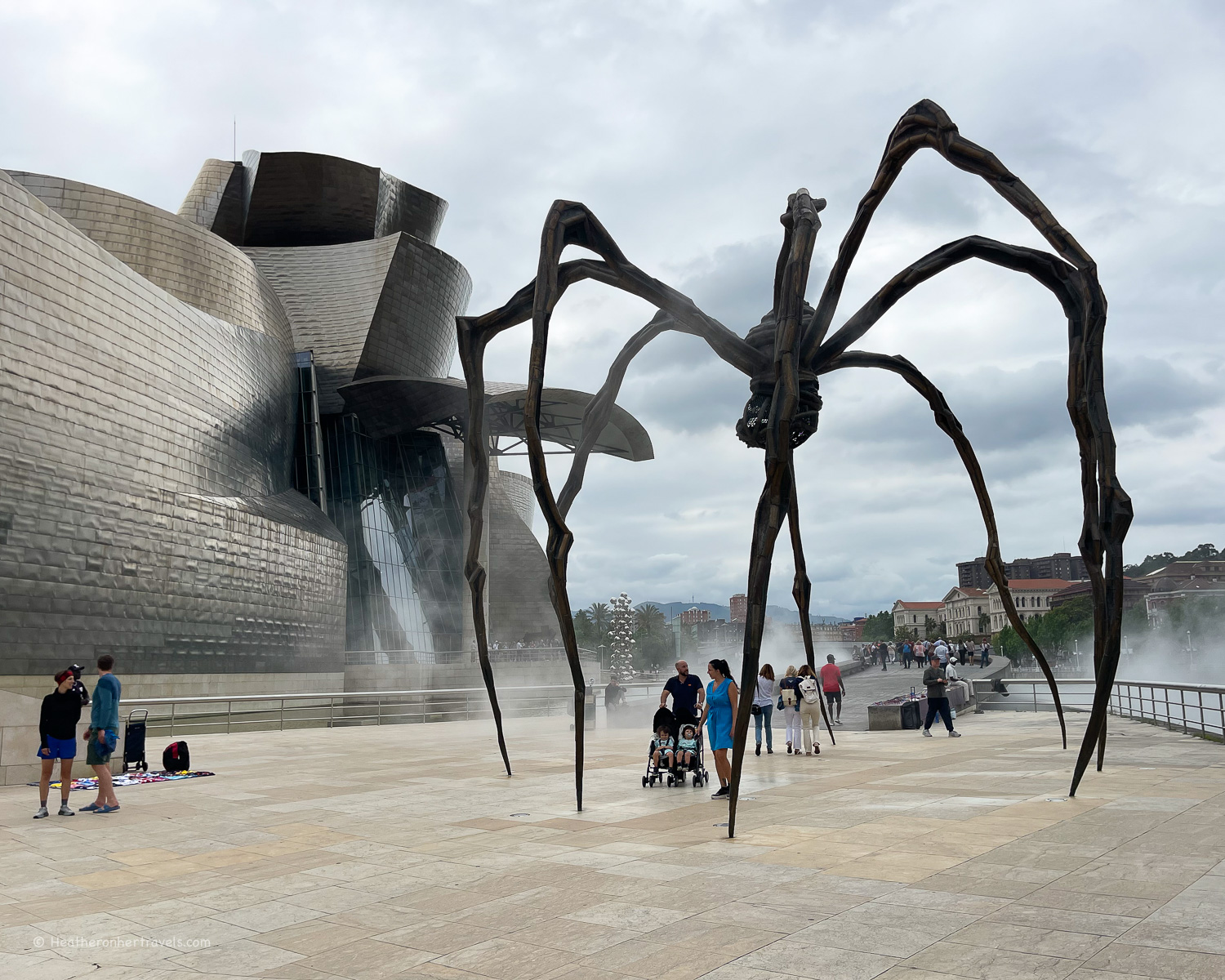
 Maman at the Guggenheim Bilbao Spain
Maman at the Guggenheim Bilbao Spain
- Tall tree and the eye by Anish Kapoor – The polished metal spheres of this tall sculpture are set in a shallow pool, like miniature worlds reflecting the Guggenheim.
- In the pool of water that surrounds the river facing side the building, look out for the misty Fog by Fujiko Nakaya, and the Fountains of fire by Yves Klein that flare up at night.

 Guggenheim Bilbao Spain
Guggenheim Bilbao Spain
Day 2 – Evening – views from Monte Artzanda
For a lovely place to take in sunset views of Bilbao, take the funicular up to Monte Artxanda. From the top of this hill, you can look down at the River Nervión snaking towards the sea, with the Guggenheim and other city landmarks laid out below you.
The ride from the bottom funicular station up the hill only takes a few minutes. At the top, there’s a spacious park to walk through, with information boards explaining how this area was once full of farms that became Siderias or cider houses.
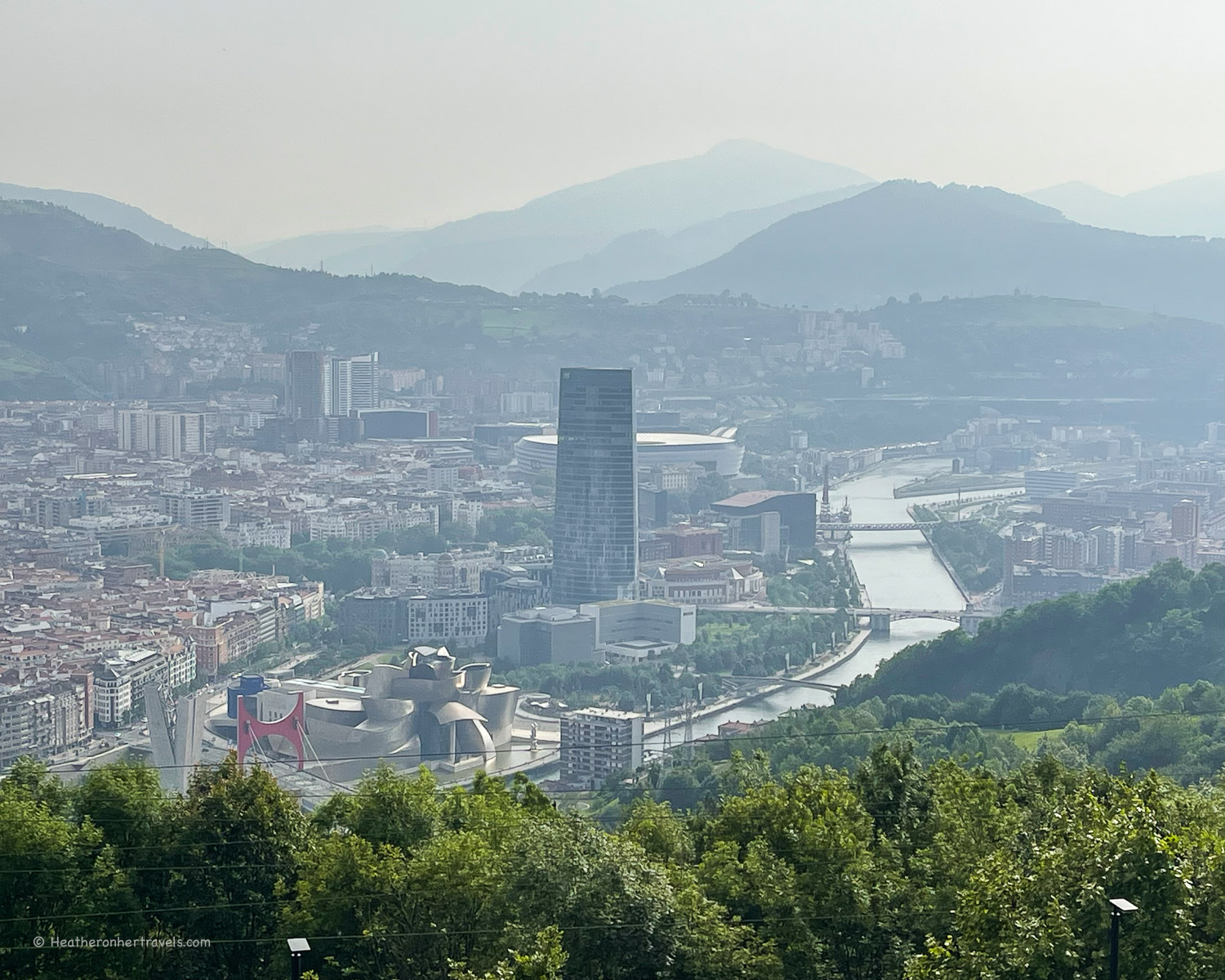
 View from the funicular of Bilbao Spain
View from the funicular of Bilbao Spain
On descending by the funicular, you can find somewhere to eat in the Abando district behind the main station, where there are plenty of restaurants. We recommend Basquery, a craft beer hall and brewery with deli and restaurant serving locally inspired dishes.
For more information on Bilbao, read my article on 19 top things to do in Bilbao.
Day 3 – Day Trip from Bilbao to San Juan de Gaztelugatxe, Bermeo and Gernkia
Today you’ll explore some of the smaller coastal towns and sights that lie to the east of Bilbao and can be reached within an hour by train or bus.
To pack in as much as possible, we decided to book a tour, so we could visit three key locations in one day, with a guide and minibus transport from central Bilbao – From Bilbao: Gaztelugatxe, Bermeo and Gernika day trip.
If you prefer to visit these locations individually, we’ve also provided details of the public transport options below.
Day 3 – San Juan de Gaztelugatxe
The photogenic chapel of San Juan (Saint John) de Gaztelugatxe is perched on top of a rocky island that’s reached by a causeway. It was used as a Game of Thrones location and is one of the most visited spots on the Basque coast.

 San Juan de Gaztelugatxe Basque Spain
San Juan de Gaztelugatxe Basque Spain
A hermitage was first built here in the 9th century and the rocky islet was later fortified. It came under attack on many occasions, with the chapel being destroyed and rebuilt several times.
The chapel is considered to bring good fortune and protection to the local fishermen who maintain it. Boats setting out on a long tuna fishing trip from Bermeo will first make turns in front of the islet to receive a blessing from Saint John. Some even say that the head of John the Baptist was buried here.

 Chapel at San Juan de Gaztelugatxe Basque Spain
Chapel at San Juan de Gaztelugatxe Basque Spain
Walking to the Hermitage
The walk to the hermitage takes around 1 hour 30 mins as a round trip. You’ll first descend on a path from the cliff, then traverse a causeway and climb a narrow path of 241 steps up to the chapel. It’s fine for anyone of reasonable fitness, but trainers or walking shoes are recommended.
While visiting San Juan de Gaztelugatxe is free, you do need to pre-book a timed entrance ticket. This will be checked at the entrance point, before you start the walk down the hill and across the causeway.
How to get to San Juan de Gaztelugatxe from Bilbao
Take the bus A3517 from San Jose Plaza (Elcano 5) in Bilbao (direction Bermeo). The bus runs around once an hour, the journey is 1 hour and you alight at the stop Gaztelu Begi near San Juan de Gaztelugatxe. Then walk 5 minutes down the hill to the ticket entrance at the start of the walk where there are restaurants and toilet facilities. Check the Bizkaibus website.
You can also book this tour from Bilbao: From Bilbao: Gaztelugatxe, Bermeo and Gernika day trip.
Day 3 – Bermeo
Close to San Juan de Gaztelugatxe is Bermeo, a pretty fishing port that was formerly a centre for the Basque whaling industry.
The town still has an active fishing industry and is especially known for the sustainably caught white “bonito” tuna. You can order it in the local restaurants that line the harbour or buy the canned tuna as a souvenir to take home.

 Bermeo Spain
Bermeo Spain
Things to do in Bermeo
- Have a relaxed lunch in one of the restaurants around the harbour, ordering the locally caught tuna or seafood – we recommend Batun Batun set just above the port.
- Wander along the long stone pier and see the mermaid statue at the port’s entrance representing the legend of Xixili, a water nymph who lured fishermen to their death.
- Visit the small but well designed Arrantzaleen Museum in the 15th century stone tower, Torre de Ercilla. It gives interesting insights into the fishing history and way of life in Bermeo.
- If you are lucky you might catch a festival day like we did, with parades of giant puppet figures accompanied by a Basque traditional band.

 Festival in Bermeo Spain
Festival in Bermeo Spain
How to get to Bermeo from Bilbao
Take the train from Zazpikaleak / Casco Viejo station in Bilbao to Bermeo. The train runs around every 30 mins, the journey is around 1 hour 20 mins. Check the Euskotren website. You can also take the A3515 bus from Bilbao but it takes a little longer at 1 hour 40 mins. Check the Bizkaibus website.
You can also book this tour from Bilbao: From Bilbao: Gaztelugatxe, Bermeo and Gernika day trip.
Day 3 – Gernika
The small inland town of Gernika (Basque) or Guernica (Spanish) is best known for the tragic events of 1937. Heavy aerial bombing by German and Italian forces in support of General Franco, virtually destroyed the town and killed many civilians during the Spanish Civil War.
The shocking bombardment inspired artists such as Picasso, whose famous Guernica painting is replicated in tiles in the town. Visiting Gernika is a good way to understand the Spanish Civil War and why the town as considered a symbol of Basque resistance.
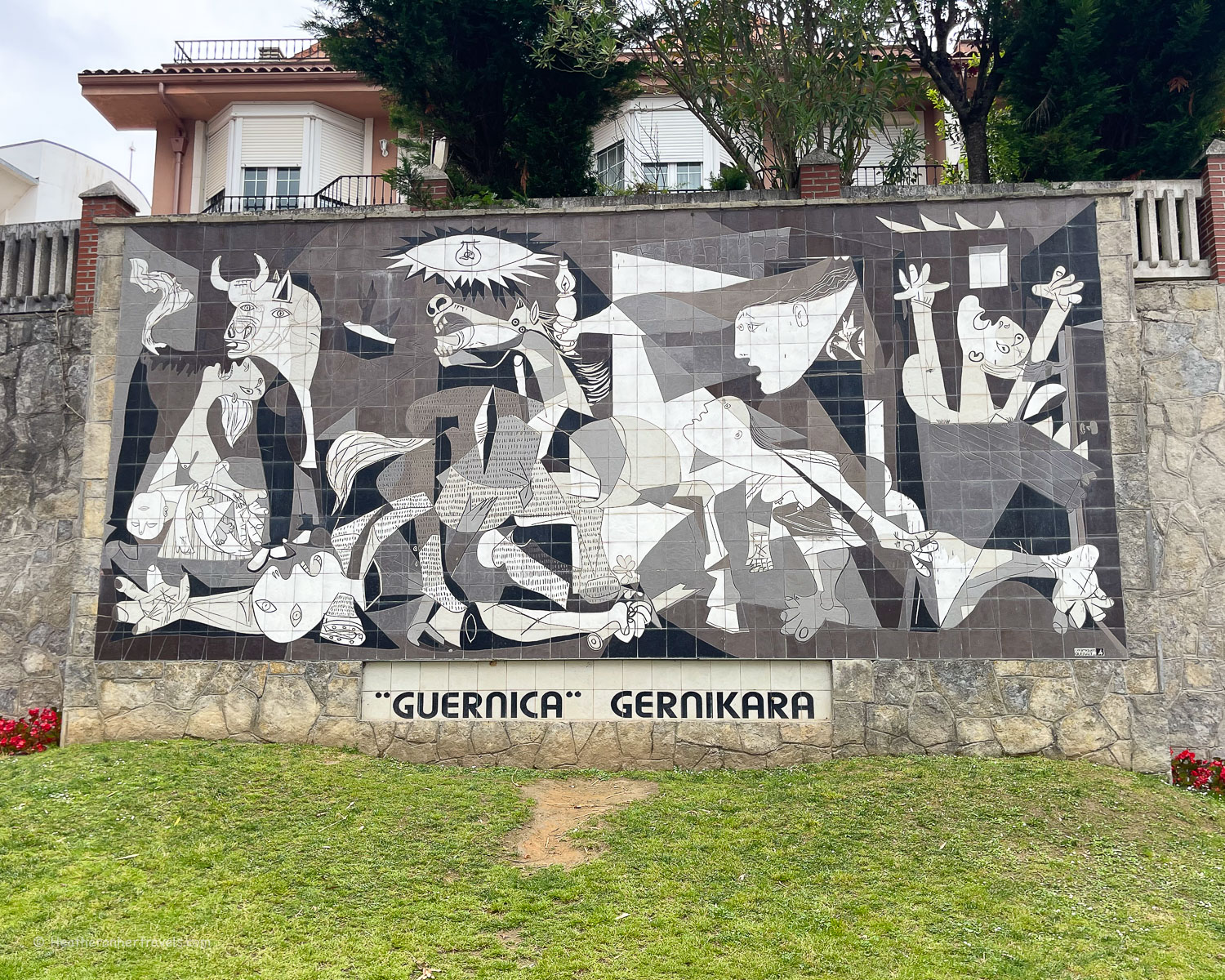
 Tiled replica of Picasso’s Guernica painting
Tiled replica of Picasso’s Guernica painting
Top things to see in Guernica
- Museo de la Paz de Guernica – the Gernika Peace Museum offers exhibitions and audio-visual presentations, providing a deeper understanding of the Spanish Civil War and the bombing of Guernica.
- Nearby is the tiled replica of Picasso’s Guernica, an anti war painting depicting the horror of the attacks in the town.
- Casa de Juntas – the Assembly House is the seat of the Basque provincial parliament and free to visit with pre-booked tickets. Four rooms are open to the public, including the hall with a beautiful stained glass roof. Outside is the stump of an old oak tree, which was the traditional spot for the members of parliament to meet, and is a symbol of Basque independence.
- In the nearby Parque de los Pueblos de Europa, look out for the sculptures by Basque sculptor Eduardo Chillida and another by Henry Moore in collaboration with Chillida.


How to get to Gernika from Bilbao
Take the train from Zazpikaleak / Casco Viejo station in Bilbao to Gernika. The train runs around every 30 mins, the journey is around 1 hour. Check the Euskotren website. There is also the option to take the A3515 or A3514 bus from Bilbao but it takes a little longer at 1 hour 10 mins. Check the Bizkaibus website.
You can also book this tour from Bilbao: From Bilbao: Gaztelugatxe, Bermeo and Gernika day trip.
Day 4 – San Sebastian – Old Town and harbour.
In the morning take the bus from Bilbao to San Sebastian, known in Basque language as Donostia. Buses run from the Intermodal bus station multiple times per day and the journey time is 1 hour 15 mins. As the intercity buses can get quite booked up, it’s advisable to book your tickets online a day or two in advance. Check the Alsa bus website.
An alternative is to take the train running every hour from Bilbao’s Zazpikaleak – Casco Viejo station to San Sebastian, but the journey time is longer at 2 hrs 40 mins, due to all the stops. Check the Euskotren train website.


Day 4 – Afternoon
Let’s start by exploring San Sebastian’s Old Town, known in Basque as the Parte Vieja. Although this was the main commercial centre from the 12th century, most of the buildings here actually date to a 19th century reconstruction.
A dark day in the town’s history is 31 August 1813, when the Anglo-Portuguese army under the Duke of Wellington stormed the city to oust the occupying French troops and burned it down in the process.

 Pinxtos in San Sebastian – Donostia Basque Spain
Pinxtos in San Sebastian – Donostia Basque Spain
Top things to do in San Sebastian’s Old Town
- Wander through the narrow pedestrianised streets packed with shops, bars and restaurants. The busiest streets are Calle 31 de Agosto and the parallel Calle de San Vincente, bisected by the Calle Major that ends in the Basilica de Santa Maria de Coro.
- Take a look behind the gorgeous Baroque facade of the Basilica de Santa Maria del Coro (Our Lady of the Choir). Completed in 1774, the basilica is one of the few buildings that survived the fire of 1813.

 Basilica de Santa Maria del Coro in San Sebastian, Spain – Donostia Basque
Basilica de Santa Maria del Coro in San Sebastian, Spain – Donostia Basque
- A contrast to the narrow streets is the open expanse of Plaza de la Constitucion. It’s a great place to relax with a drink from one of the bars that shelter under the stone arcades. The numbers on balconies that overlook the square indicate the boxes from which the wealthy could observe the bull fights held here.

 Plaza de la Constitucion in San Sebastian Spain – Donostia
Plaza de la Constitucion in San Sebastian Spain – Donostia
- Visit the San Telmo Museum located in a 16th century Dominican convent, incorporating the original cloisters. The museum’s highlight is the monumental collection of Sert Canvases, on display in the former church of the convent. San Telmo museum is a great place for a deep dive into Basque history and culture.
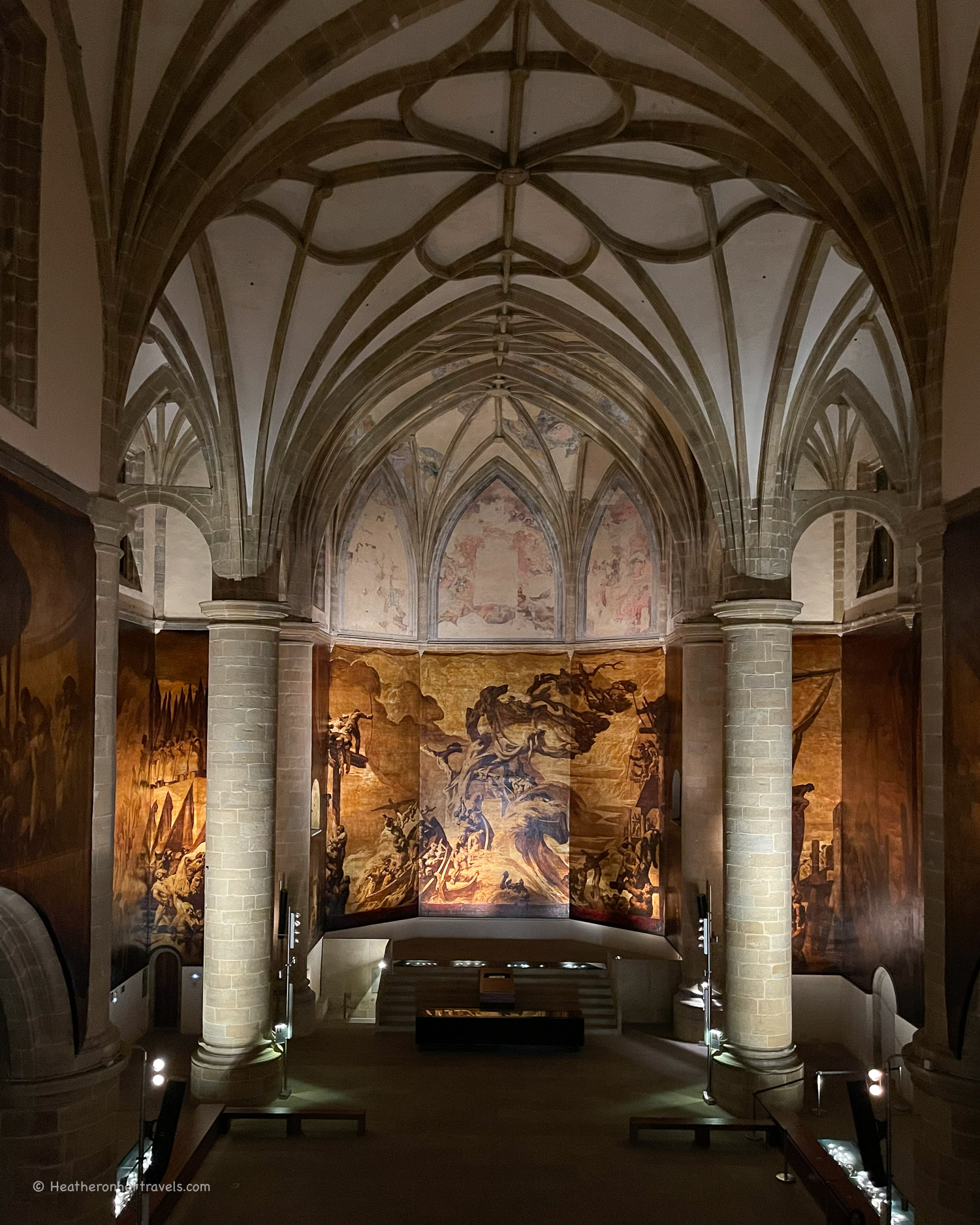
 Sert Canvases – San Telmo Museum in San Sebastian / Donostia Basque Spain
Sert Canvases – San Telmo Museum in San Sebastian / Donostia Basque Spain
Day 4 – Evening
Continue your wanderings to the nearby Old Port. It’s one of the few parts of the Old Town that survived the fire of 1813. These days you’ll find a marina full of smaller leisure and fishing boats, surrounded by cute houses.

 Old Port of San Sebastian – Donostia Basque Spain
Old Port of San Sebastian – Donostia Basque Spain
If you’re interested in Naval history, stop by at the small museum in an 18th century tower house to learn about San Sebastian’s sailing traditions. San Sebastian’s popular aquarium also overlooks the port. In the corner of the Old Port, there’s a ticket kiosk and boats run through the day to Isla Santa Clara in the middle of the bay.
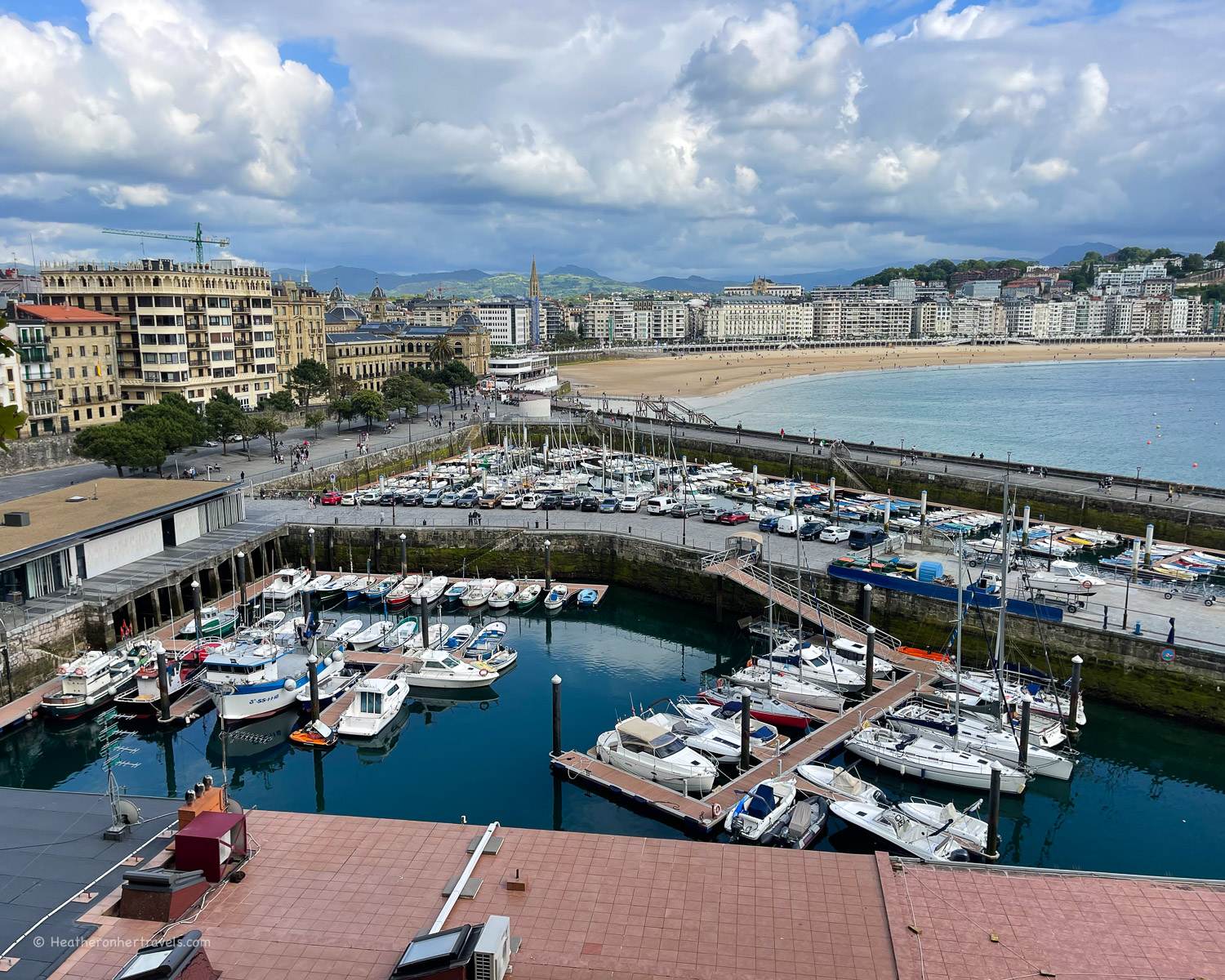
 Old Port at San Sebastian – Donostia Basque Spain
Old Port at San Sebastian – Donostia Basque Spain
There are plenty of fish and seafood restaurants here, so it’s a great place to have dinner. The large seafood restaurant of Kofradia overlooking the harbour is a good choice, but there are several to choose from. For a local speciality, try the sustainably fished Bonita tuna, which comes from nearby Bermeo.
For more information on San Sebastian, read my article on 20 best things to do in San Sebastian.
Day 5 – San Sebastian – beaches and pintxos
Spend the day exploring the beaches of San Sebastian, especially the long sweep of golden sand at La Concha beach. This Centro district expanded from the 1840s, when royal patronage made San Sebastian a fashionable spot for sea bathing.
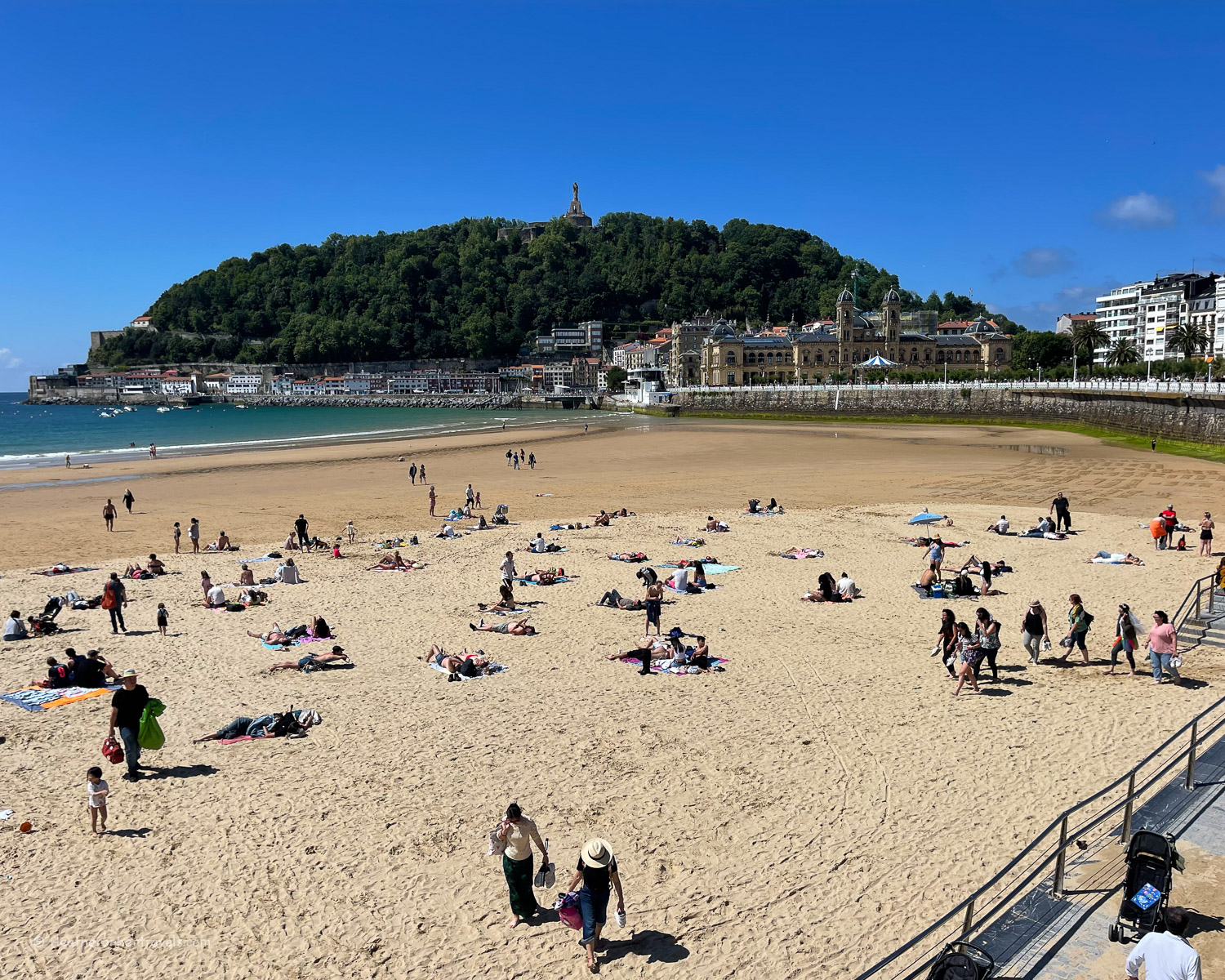
 La Concha Beach San Sebastian _ Donostia Basque Spain
La Concha Beach San Sebastian _ Donostia Basque Spain
The beaches and bay of San Sebastian
Day 5 – Morning
- Stroll along La Concha’s beachfront, bounded by the famous white wrought iron railings. At low tide, the beach is often used by artists who use the flat sand as their canvas. Watch the world go by in Parque de Alderdi Eder, relax on the beach or swim if the weather is fine.
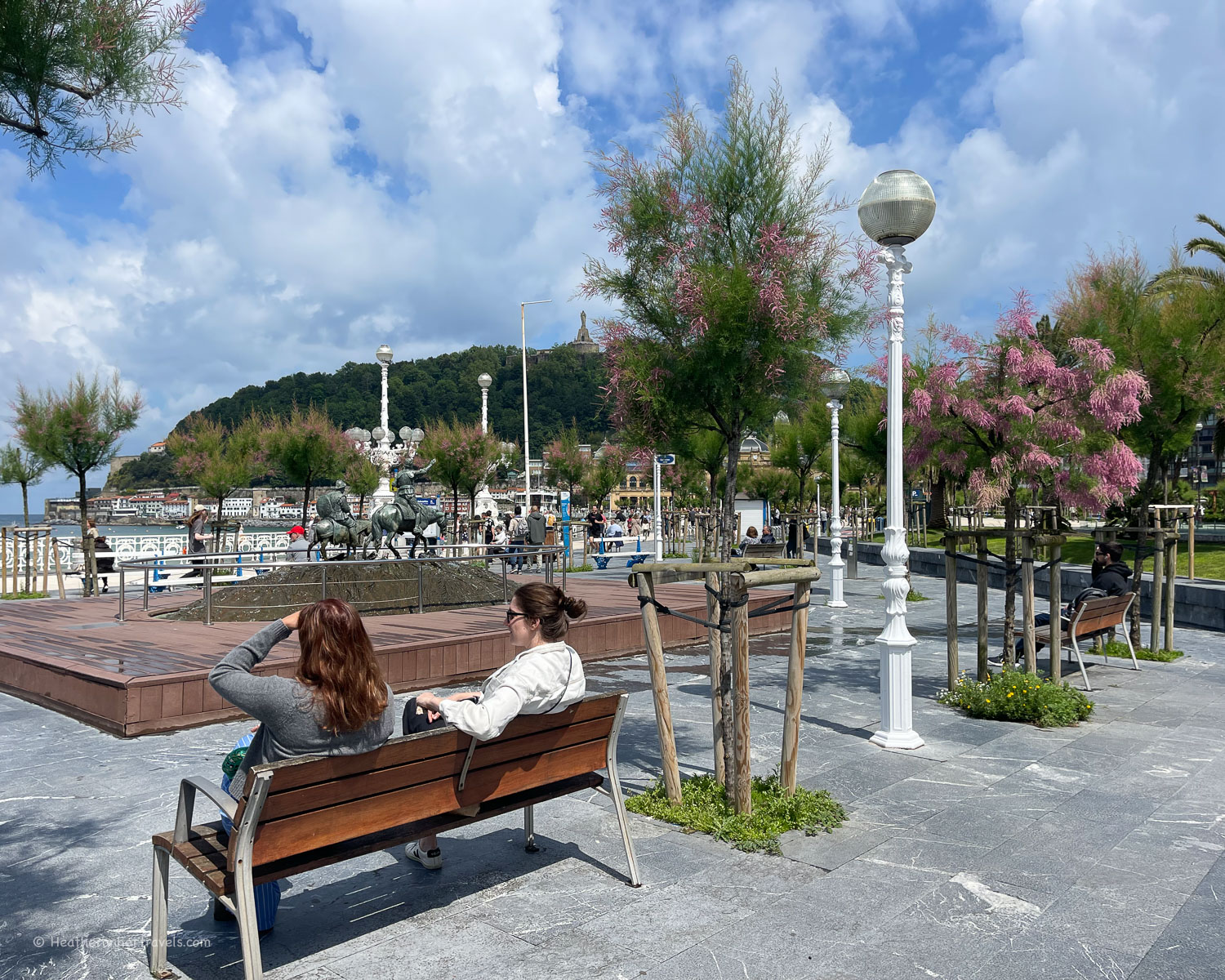
 Tamarind trees in flower at Parque de Alderdi Eder in San Sebastian – Donostia Basque Spain
Tamarind trees in flower at Parque de Alderdi Eder in San Sebastian – Donostia Basque Spain
- Halfway along La Concha beach is La Perla spa, located in one of the original sea bathing pavilions from the 19th century. The spa continues the tradition of Thalassotherapy or treatment in sea water, with saunas and indoor pools as well as direct beach access. You might like to book a session here, especially in the cooler months.

 Playa La Concha San Sebastian – Donostia Basque Spain
Playa La Concha San Sebastian – Donostia Basque Spain
- If you are feeling more active, head to Zurriola beach, in the trendy Gros neighbourhood, which has bigger waves that make this a great location for surfing. You could arrange a lesson or rent a surf board from one of the surf schools located nearby, such as Bera Bera surf school or Pukas Surf.

 Zurriola beach from Mount Urgull in San Sebastian – Donostia Basque Spain
Zurriola beach from Mount Urgull in San Sebastian – Donostia Basque Spain
Day 5 – Afternoon
- For fantastic views over San Sebastian, climb Monte Urgull, the wooded hill that overlooks the town at one end of La Concha bay. This green space is accessed by pedestrian paths starting either behind San Telmo museum or the Old Port. A path winds through shady trees up to the 12th century fortress of Castilla de la Mota, with a 40ft looming statue of the Sacred Heart from the Franco era.

 Monte Urgull in San Sebastian _ Donostia Basque Spain
Monte Urgull in San Sebastian _ Donostia Basque Spain
- In fine weather you could also take a boat ride from the Old Port to Isla Santa Clara in the middle of the bay, for the bargain price of €4 return. It’s a 10 minute boat trip and there’s a tiny beach, cafe and wooded area to have a picnic. Inside the old lighthouse is the free Hondalea art installation, a metal sculpted version of barnacle covered rocks, with the tide washing through them.

 Boat trip to Santa Clara Island San Sebastian – Donostia Basque Spain
Boat trip to Santa Clara Island San Sebastian – Donostia Basque Spain
Day 5 – Evening
As evening falls, it’s time to dive into the Pintxos scene, to try the small bites that are the Basque country’s answer to tapas.
A good place to start your Pintxos experience is in the Old Town, where there are numerous bars packed together. Tempting plates of cold Pintxos are laid out on bar tops, while the more substantial racionnes or small plates can be ordered from the menu.

 Pinxtos in San Sebastian – Donostia Basque Spain
Pinxtos in San Sebastian – Donostia Basque Spain
Follow the locals who go bar-hopping to try a drink and one or two Pintxos at each one. At the same time, you might try the fresh local white wine, called Txakoli (pronounced Cha – ko – li ), which is poured from a height to give it some fizz.
If a bar is packed it’s normally a good sign of quality, so don’t be put off by the crowds, as service is invariably brisk and efficient.

 Heather on the Pinxtos tour in San Sebastian – Donostia Basque Spain
Heather on the Pinxtos tour in San Sebastian – Donostia Basque Spain
Another good way to try the Pintxos experience, especially to familiarise yourself when you arrive, is to take a Pintxos bar hopping tour, like the Old Town Pintxos tour that we enjoyed with Devour Tours.
Devour run food tours all over Europe and you could also try their Pinxtos tours in the less touristy Centro neighbourhood as well as this fun Basque cookery class.

 Gilda Pinxtos in San Sebastian – Donostia Basque Spain
Gilda Pinxtos in San Sebastian – Donostia Basque Spain
For more information on San Sebastian, read my article on 20 best things to do in San Sebastian.
Day 6 – Day Trip from San Sebastian to Getaria or Hondarribia
Having explored the highlights of San Sebastian, today we’ll make a day trip to one of the coastal towns that are an easy bus ride from the city. Since Getaria and Hondarribia are in opposite directions, we recommend choosing one, as you can’t easily do them both in a day.
Alternatively you could spend the morning at either of these towns, then return to San Sebastian for more sightseeing in the afternoon.
Day 6 – Getaria
Getaria is a charming small town, but its main attraction for lovers of design and fashion is the stunning Cristobal Balenciaga Museum.

 Getaria in Basque Spain
Getaria in Basque Spain
The 14th century Iglesia de San Salvado, at the end of the main street has an unusual sloping floor reminiscent of a ship. Beyond the church is the port area, with a number of restaurants that specialise in fresh fish grilled over charcoal.
It was from here that the navigator Juan Sebastian Elcano left in 1519 to circumnavigate the globe on Magellan’s ship, one of the few sailors to return from the voyage. He is much celebrated in Getaria and you’ll see his statue outside the town hall and by the port.
On the hill above the old town is the museum dedicated to fashion designer Cristobal Balenciaga. He was born in Getaria and was at the peak of his influence as a master of couture in the 1950s and 1960s. The museum is full of gorgeous gowns, that trace the development of the Balenciaga style, with innovative silhouettes worn by the rich and famous.

 Cristobal Balenciaga Museum San Sebastian – Donostia Basque Spain
Cristobal Balenciaga Museum San Sebastian – Donostia Basque Spain
Getting there: Take the UK11 bus, which is the quicker route as it goes via the motorway or the UK9 bus which takes a slightly longer and more scenic route via the villages. The bus starts in San Sebastian at Libertad 34 in the Centro district and takes 35-45 minutes. More information on the Lurralde Bus website.
Day 6 – Hondarribia
The walled old town of Hondarribia dates back to the 15th century, and reminded me a little of Alsace, with its half timbered houses and pretty flower filled balconies. There are a couple of attractive squares, including Plaza de Armas in front of the church, where we stopped for coffee, near the medieval Parador hotel and tourist information centre.
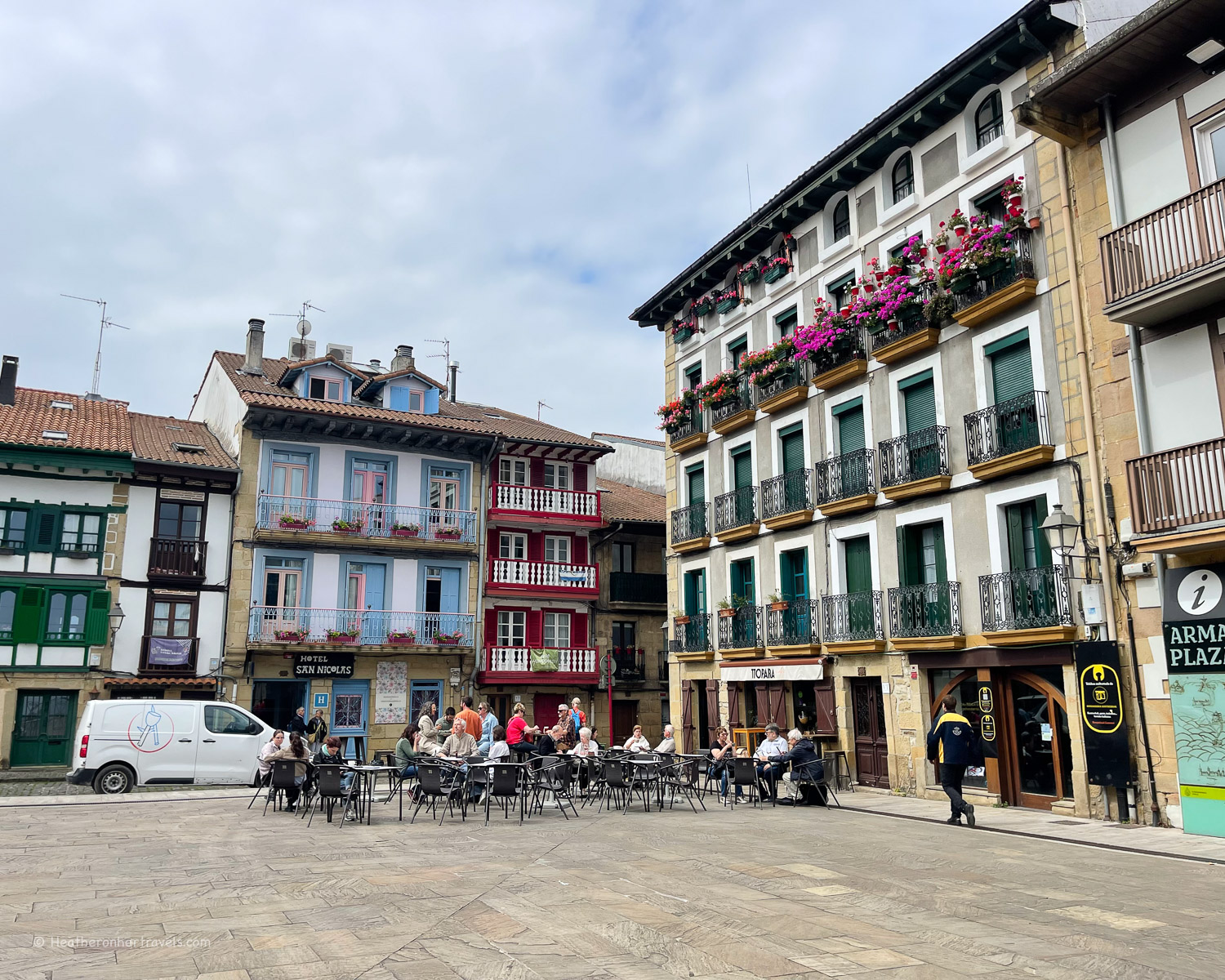
 Hondarribia in Basque Spain
Hondarribia in Basque Spain
Down the hill is the La Marina district, with a pedestrianised street full of colourful fishermen’s houses. Many are now bars and restaurants, so this is an excellent place for lunch, especially if you want to try the local seafood or Sopa de Pescado (fish soup).
A 20 minute stroll along the river front will bring you past the marina where there’s a whole row of bars and restaurants. Just beyond is the Playa de Hondarribia, with a flat stretch of sand, partly backed by a nature reserve. Returning to the La Marina district, you can catch the bus from here back to San Sebastian.
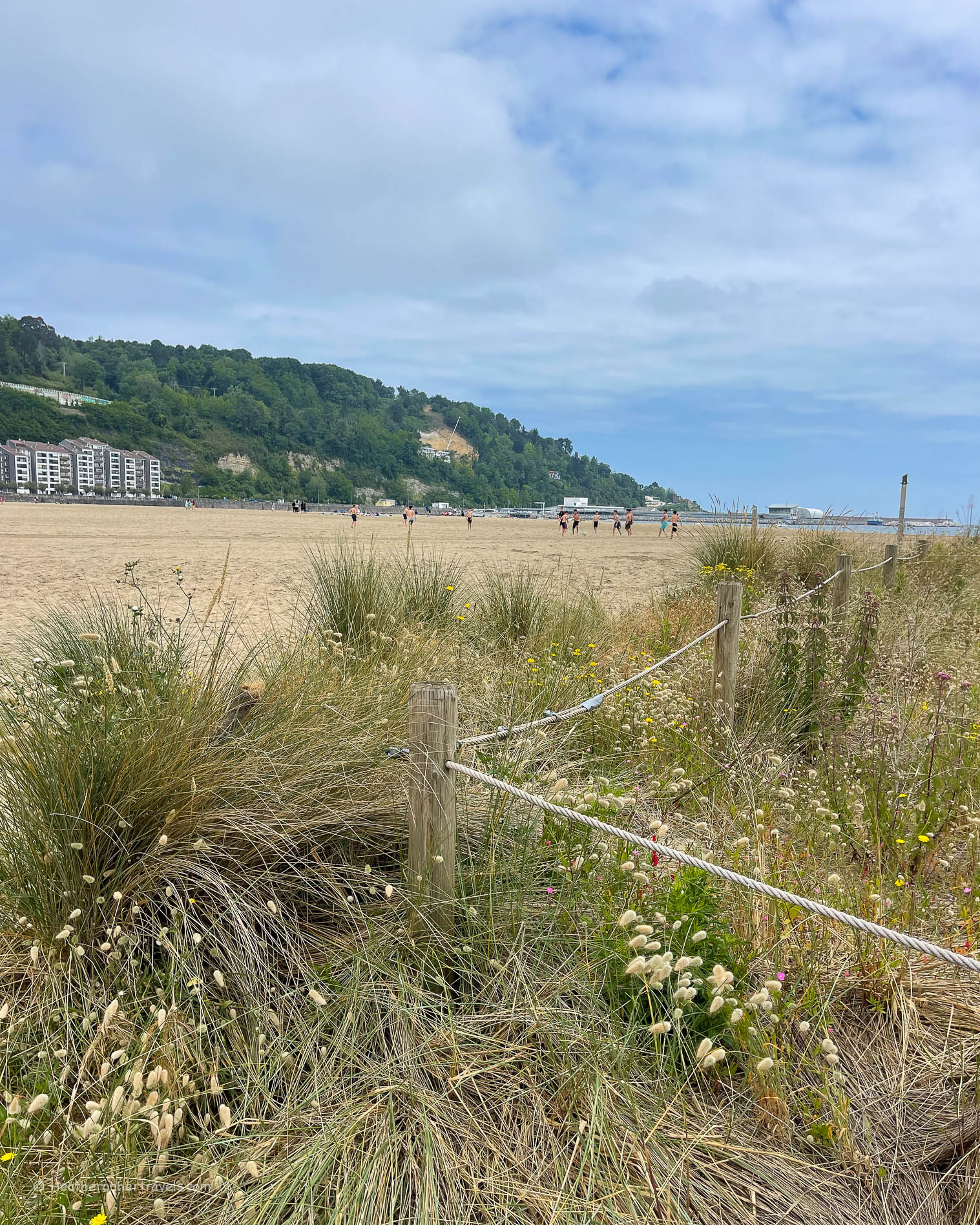
 Playa de Hondarribia Basque Spain
Playa de Hondarribia Basque Spain
Getting there: Take the E21 bus from Gipuzkoa Plaza via the San Sebastian airport, and get off near the Casco Historico of Hondarribia. There are other E buses that will also take you there on slightly different routes – check on the Ekialdebus website.
Day 7 – San Sebastian – Monte Igueldo and departure
Day 7 – Morning
On your final morning let’s head to the far end of the bay, to explore the area around Monte Igueldo. A short bus ride or a leisurely stroll along La Concha beach will bring you to Ondarreta Beach, which shares the same broad stretch of golden sand.

 Playa Ondarreta in San Sebastian – Donostia Basque Spain
Playa Ondarreta in San Sebastian – Donostia Basque Spain
The shallow water makes it an ideal family beach, backed by a pretty public park, with gravel paths and tamarisk trees. When the sea is calm, confident swimmers can swim from here to Santa Clara Island in the middle of the bay.
At the end of Ondarreta beach, look for the wilder area of rocks where the three sculptures by Edward Chillida are installed. Known as the Peine del Viento or “Comb of the wind” these eroded iron hook sculptures are inspired by the wind and waves that Chillida loved to watch as a boy.

 Comb of the Wind at San Sebastian – Donostia Basque Spain
Comb of the Wind at San Sebastian – Donostia Basque Spain
The blow holes in the cobbled terrace make an eerie sound, as the wind is forced through them, spouting unexpected sprays of sea water.

 Views from Monte Igueldo in San Sebastian – Donostia Basque Spain
Views from Monte Igueldo in San Sebastian – Donostia Basque Spain
Overlooking Ondarreta Beach is Monte Igueldo, a green and wooded hill with a vintage funicular to take you up to the viewing terrace. The small amusement park at the top dates back to the 20th century, with old fashioned carousels, roller coaster and funfair rides.
Enjoy the sweeping views across the bay towards La Concha beach and the Old Town, before descending by foot on the winding road or the funicular.
Day 7 – Afternoon
If you’ve only got 7 days in Spain’s Basque Country, you’ll probably be heading to the airport at Bilbao or Biarritz, or catching the bus or train to another region of Spain. But if you want to extend your visit, there are a few more places you could visit in San Sebastian, Bilbao and the Basque coast and countryside.

 Vizcaya Bridge Bilbao Spain
Vizcaya Bridge Bilbao Spain
10 days itinerary for Basque Spain
If you have more time to spare you could add on some extra days to the week’s itinerary:
- Take a day trip from San Sebastian to Getaria or Hondarribia, whichever you didn’t see in the first week
- From San Sebastian, visit the picturesque town of St-Jean-de-Luz, a short hop across the border in Basque France.
- From central Bilbao visit the neighbourhoods of Portugalete and Getxo at the mouth of the River Nervion estuary – to see the famous Vizcaya transporter bridge and enjoy the beaches of Getxo.

 Old Port of San Sebastian – Donostia Basque Spain
Old Port of San Sebastian – Donostia Basque Spain
Read Next
Read about 19 things to do in Bilbao Spain

 Things to do in Bilbao Spain
Things to do in Bilbao Spain
Pin it!


This article is originally published at Heatheronhertravels.com


Please visit:
Our Sponsor
